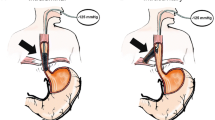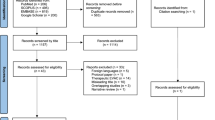Abstract
Background
Perforations and anastomotic leaks of the gastrointestinal tract are severe complications, which carry high morbidity and mortality and management of these is a multi-disciplinary challenge. The use of endoluminal vacuum (EVAC) therapy has recently proven to be a useful technique to manage these complications. We report our institution’s experience with this novel technique in the chest, abdomen, and pelvis.
Methods
This is a retrospective review of an IRB approved registry of all EVAC therapy patients from July 2013 to December 2016. A total of 55 patients were examined and 49 patients were eligible for inclusion: 15 esophageal, 21 gastric, 3 small bowel, and 10 colorectal defects. The primary endpoint was closure rate of the GI tract defect with EVAC therapy.
Results
Fifteen (100%) esophageal defects closed with EVAC therapy. Mean duration of therapy was 27 days consisting of an average of 6 endosponge changes every 4.8 days. Eighteen (86%) gastric defects closed with EVAC therapy. Mean duration of therapy was 38 days with a mean of 9 endosponge changes every 5.3 days. Three (100%) small bowel defects closed with EVAC therapy. Mean duration of therapy was 13.7 days with a mean of 2.7 endosponge changes every 4.4 days. Six (60%) colorectal defects closed with EVAC therapy. Mean duration of therapy was 23.2 days, consisting of a mean of 6 endosponge changes every 4.0 days. There were two deaths, which were not directly related to EVAC therapy and occurred outside the measured 30-day mortality.
Conclusion
Our experience demonstrates that EVAC therapy is feasible and effective for the management of gastrointestinal perforations/leaks throughout the GI tract and can be considered as a safe alternative to surgical intervention in select cases.



Similar content being viewed by others
References
Brinster CJ, Singhal S, Lee L, Marshall MB, Kaiser LR, Kucharczuk JC (2004) Evolving options in the management of esophageal perforation. Ann Thorac Surg 77:1475–1483
Borejsza-Wysocki M, Szmyt K, Bobkiewicz A, Malinger S, Swirkowicz J, Hermann J, Drews M, Banasiewicz T (2015) Endoscopic vacuum-assisted closure system (E-VAC): case report and review of the literature. Wideochir Inne Tech Maloinwazyjne 10:299–310
Lang H, Piso P, Stukenborg C, Raab R, Jahne J (2000) Management and results of proximal anastomotic leaks in a series of 1114 total gastrectomies for gastric carcinoma. Eur J Surg Oncol 26:168–171
Caulfield H, Hyman NH (2013) Anastomotic leak after low anterior resection: a spectrum of clinical entities. JAMA Surg 148:177–182
Sakran N, Goitein D, Raziel A, Keidar A, Beglaibter N, Grinbaum R, Matter I, Alfici R, Mahajna A, Waksman I, Shimonov M, Assalia A (2013) Gastric leaks after sleeve gastrectomy: a multicenter experience with 2834 patients. Surg Endosc 27:240–245
Markar SR, Arya S, Karthikesalingam A, Hanna GB (2013) Technical factors that affect anastomotic integrity following esophagectomy: systematic review and meta-analysis. Ann Surg Oncol 20:4274–4281
Kassis ES, Kosinski AS, Ross P Jr, Koppes KE, Donahue JM, Daniel VC (2013) Predictors of anastomotic leak after esophagectomy: an analysis of the society of thoracic surgeons general thoracic database. Ann Thorac Surg 96:1919–1926
Arezzo A, Miegge A, Garbarini A, Morino M (2010) Endoluminal vacuum therapy for anastomotic leaks after rectal surgery. Techn Coloproctol 14:279–281
Mees ST, Palmes D, Mennigen R, Senninger N, Haier J, Bruewer M (2008) Endo-vacuum assisted closure treatment for rectal anastomotic insufficiency. Dis Colon Rectum 51:404–410
Mennigen R (2014) Novel treatment options for perforations of the upper gastrointestinal tract: endoscopic vacuum therapy and over-the-scope clips. World J Gastroenterol 20:7767
Goenka MK, Goenka U (2015) Endotherapy of leaks and fistula. World J Gastrointest Endosc 7:702–713
Manta R, Magno L, Conigliaro R, Caruso A, Bertani H, Manno M, Zullo A, Frazzoni M, Bassotti G, Galloro G (2013) Endoscopic repair of post-surgical gastrointestinal complications. Dig Liver Dis 45:879–885
Brangewitz M, Voigtlander T, Helfritz FA, Lankisch TO, Winkler M, Klempnauer J, Manns MP, Schneider AS, Wedemeyer J (2013) Endoscopic closure of esophageal intrathoracic leaks: stent versus endoscopic vacuum-assisted closure, a retrospective analysis. Endoscopy 45:433–438
Ahrens M (2010) Drainage of esophageal leakage using endoscopic vacuum therapy: a prospective pilot study. Endoscopy 42:693–698
Schniewind B, Schafmayer C, Voehrs G, Egberts J, von Schoenfels W, Rose T, Kurdow R, Arlt A, Ellrichmann M, Jurgensen C, Schreiber S, Becker T, Hampe J (2013) Endoscopic endoluminal vacuum therapy is superior to other regimens in managing anastomotic leakage after esophagectomy: a comparative retrospective study. Surg Endosc 27:3883–3890
Smallwood NR, Fleshman JW, Leeds SG, Burdick JS (2015) The use of endoluminal vacuum (E-Vac) therapy in the management of upper gastrointestinal leaks and perforations. Surg Endosc 30(6):2473–2480
Bludau M, Holscher AH, Herbold T, Leers JM, Gutschow C, Fuchs H, Schroder W (2014) Management of upper intestinal leaks using an endoscopic vacuum-assisted closure system (E-VAC). Surg Endosc 28:896–901
Leeds SG, Burdick JS (2016) Management of gastric leaks after sleeve gastrectomy with endoluminal vacuum (E-Vac) therapy. Surg Obes Relat Dis 12(7):1278–1285
Lee S, Ahn JY, Jung HY, Lee JH, Choi KS, Kim do H, Choi KD, Song HJ, Lee GH, Kim JH, Kim BS, Yook JH, Oh ST, Kim BS, Han S (2013) Clinical outcomes of endoscopic and surgical management for postoperative upper gastrointestinal leakage. Surg Endosc 27:4232–4240
Dindo D, Demartines N, Clavien PA (2004) Classification of surgical complications: a new proposal with evaluation in a cohort of 6336 patients and results of a survey. Ann Surg 240:205–213
Persson S, Elbe P, Rouvelas I, Lindblad M, Kumagai K, Lundell L, Nilsson M, Tsai JA (2014) Predictors for failure of stent treatment for benign esophageal perforations—a single center 10-year experience. World J Gastroenterol 20:10613–10619
de Lima KV, Costa MJ, Goncalves Mda C, Sousa BS (2013) Micronutrient deficiencies in the pre-bariatric surgery. Arquivos brasileiros de cirurgia digestiva 26(Suppl 1):63–66
Barbour JR, Iorio ML, Oh C, Tung TH, O’Neill PJ (2015) Predictive value of nutritional markers for wound healing complications in bariatric patients undergoing panniculectomy. Ann Plast Surg 75:435–438
Schorsch T, Muller C, Loske G (2014) Endoscopic vacuum therapy of perforations and anastomotic insufficiency of the esophagus. Der Chirurg; Zeitschrift fur alle Gebiete der operativen Medizen 85:1081–1093
Riss S, Stift A, Meier M, Haiden E, Grunberger T, Bergmann M (2010) Endo-sponge assisted treatment of anastomotic leakage following colorectal surgery. Colorectal Dis 12:e104–e108
Huser N, Michalski CW, Erkan M, Schuster T, Rosenberg R, Kleeff J, Friess H (2008) Systematic review and meta-analysis of the role of defunctioning stoma in low rectal cancer surgery. Ann Surg 248:52–60
Chopra SS, Mrak K, Hunerbein M (2009) The effect of endoscopic treatment on healing of anastomotic leaks after anterior resection of rectal cancer. Surgery 145:182–188
Funding
This research did not receive any specific grant from funding agencies in the public, commercial, or not-for-profit sectors.
Author information
Authors and Affiliations
Corresponding author
Ethics declarations
Disclosures
Marissa A. Mencio: No disclosures to report. Estrellita Ontiveros: No disclosures to report. James S. Burdick: No disclosures to report. Steven G. Leeds: Consultant for Ethicon and Torax. No relevant disclosures to report for this manuscript.
Rights and permissions
About this article
Cite this article
Mencio, M.A., Ontiveros, E., Burdick, J.S. et al. Use of a novel technique to manage gastrointestinal leaks with endoluminal negative pressure: a single institution experience. Surg Endosc 32, 3349–3356 (2018). https://doi.org/10.1007/s00464-018-6055-x
Received:
Accepted:
Published:
Issue Date:
DOI: https://doi.org/10.1007/s00464-018-6055-x




